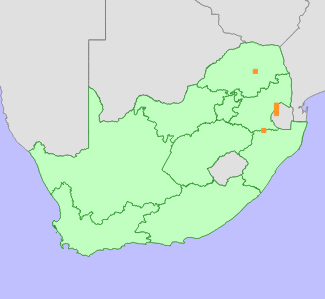|
Scientific Name | Brachystelma villosum (Schltr.) N.E.Br. |
Higher Classification | Dicotyledons |
Family | APOCYNACEAE |
National Status |
Status and Criteria | Data Deficient - Insufficient Information |
Assessment Date | 2018/05/25 |
Assessor(s) | L. von Staden |
Justification | A widespread (EOO at least 17 500 km²), but rarely recorded and very poorly known species, but may be overlooked. It is possibly threatened by habitat loss and degradation, but not enough is known about its population size and trends to evaluate against the criteria. |
Distribution |
Endemism | Not endemic to South Africa |
Provincial distribution | KwaZulu-Natal, Limpopo, Mpumalanga |
Range | Haenertsburg to New Castle. Also occurs in Swaziland. |
Habitat and Ecology |
Major system | Terrestrial |
Major habitats | Woodbush Granite Grassland, Barberton Montane Grassland, KaNgwane Montane Grassland, Paulpietersburg Moist Grassland |
Description | Scattered in grassland at an altitude of 500-1500 m. |
Threats |
| Around Haenertsburg, much of this species' montane grassland habitat has been converted to timber plantations, and only small fragments remain. However, in the nearby Wolkberg Wilderness Area, where this species is likely to occur, large areas of natural grasslands remain intact within a protected wilderness area, but is dependent on continued good conservation management, especially clearing of alien invasive plants. Similarly, around Barberton, grasslands have also been extensively converted to timber plantations. There is also renewed interest in mining in the area, with a number of mining applications currently under review. In northern KwaZulu-Natal, it is potentially threatened by habitat loss and degradation due to expanding timber plantations and overgrazing. A subpopulation recorded near Mhlambanyati in Swaziland is likely to have been lost to timber plantations, but it has also recently been recorded from Malolotja Nature Reserve, where its grassland habitat is well-protected. |
Population |
Brachystelma villosum is widespread across the high-altitude grasslands of eastern South Africa and Swaziland, but has been very rarely recorded. In South Africa, it is known from only three records, the most recent collected in 1992. Locality descriptions are imprecise, and it is difficult to trace even known subpopulations. It is possibly rare, but may also be overlooked as plants are small and cryptic. The most recent record, was found after a fire (recorded in 1992 from Swaziland), indicating that plants may only be visible in post-fire conditions. Specimen notes indicate that the species is uncommon. It also flowers relatively early (July-October), outside the main summer-rainfall flowering season, which may also contribute to it being overlooked. Across most of its range it is likely to have declined due to habitat loss to timber plantations, but with the current poor knowledge of the population, it is not possible to assess it against the criteria. Surveys are needed to gain a better understanding of the range and abundance of this species. It is likely to occur on the high eastern escarpment between Haenertsburg and Barberton, but has never been recorded there.
|
Population trend | Unknown |
Assessment History |
Taxon assessed |
Status and Criteria |
Citation/Red List version | | Brachystelma villosum (Schltr.) N.E.Br. | Data Deficient | 2015.1 | | Brachystelma villosum (Schltr.) N.E.Br. | Rare | Raimondo et al. (2009) | |
Bibliography |
Brown, N.E. 1909. Asclepiadeae. In: W.T. Thiselton-Dyer (ed). Flora Capensis IV Section I (Vacciniaceae to Gentianeae):518-1036. Lovell Reeve & Co., Ltd., London.
Dyer, R.A. 1980. Brachystelma, Ceropegia and Riocreuxia. In: O.A. Leistner (ed). Flora of Southern Africa 27 Part 4:1-88. Botanical Research Institute, Pretoria.
Dyer, R.A. 1983. Ceropegia, Brachystelma and Riocreuxia in southern Africa. A.A. Balkema, Rotterdam, Netherlands.
Raimondo, D., von Staden, L., Foden, W., Victor, J.E., Helme, N.A., Turner, R.C., Kamundi, D.A. and Manyama, P.A. 2009. Red List of South African Plants. Strelitzia 25. South African National Biodiversity Institute, Pretoria.
|
Citation |
| von Staden, L. 2018. Brachystelma villosum (Schltr.) N.E.Br. National Assessment: Red List of South African Plants version 2024.1. Accessed on 2025/11/30 |
 Comment on this assessment
Comment on this assessment


